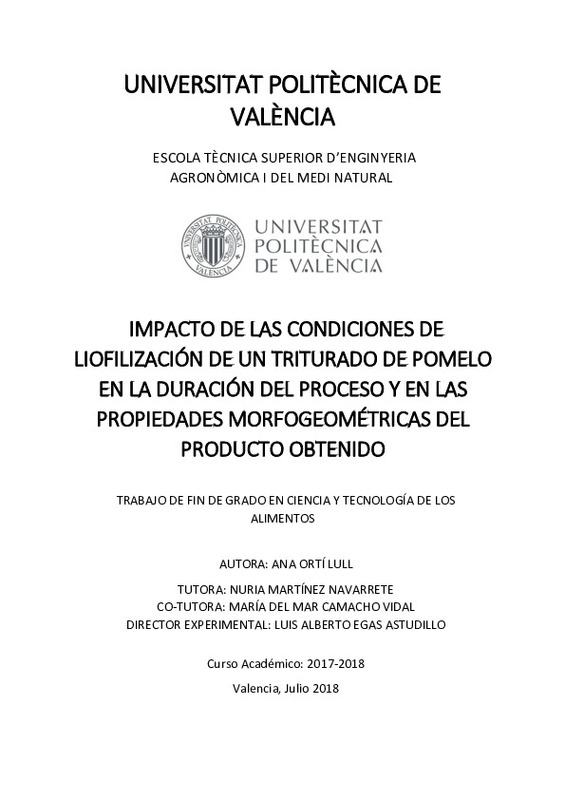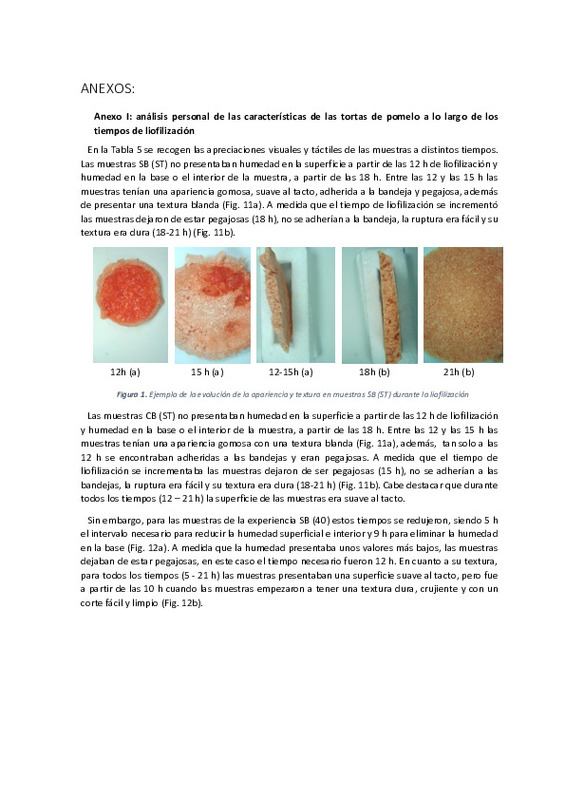JavaScript is disabled for your browser. Some features of this site may not work without it.
Buscar en RiuNet
Listar
Mi cuenta
Estadísticas
Ayuda RiuNet
Admin. UPV
Impacto de las condiciones de liofilización de un triturado de pomelo en la duración del proceso y en las propiedades morfogeométricas del producto obtenido
Mostrar el registro sencillo del ítem
Ficheros en el ítem
| dc.contributor.advisor | Camacho Vidal, Mª Mar
|
es_ES |
| dc.contributor.advisor | Martínez Navarrete, Nuria
|
es_ES |
| dc.contributor.advisor | Egas Astudillo, Luis Alberto
|
es_ES |
| dc.contributor.author | Ortí Lull, Ana
|
es_ES |
| dc.date.accessioned | 2018-10-11T10:41:44Z | |
| dc.date.available | 2018-10-11T10:41:44Z | |
| dc.date.created | 2018-09-24 | |
| dc.date.issued | 2018-10-11 | es_ES |
| dc.identifier.uri | http://hdl.handle.net/10251/110188 | |
| dc.description.abstract | [ES] La liofilización es una tecnología de deshidratación en frío que reduce las pérdidas de compuestos lábiles, muchos de ellos responsables del sabor, aroma y valor nutritivo de alimentos, además de permitir estabilizar y conservar los productos durante periodos de tiempo largos. Hoy en día estas características de calidad en un producto están muy valoradas por el consumidor de alta cocina o cocina gourmet, que puede encontrar en los alimentos liofilizados una nueva oferta de platos de gran calidad nutritiva y organoléptica. No obstante, el proceso de liofilización es lento, resultando una tecnología costosa que repercute en el precio final del producto. Por ello, cualquier intento de acortar el tiempo de proceso podrá permitir competir con los diferentes productos deshidratados que ofrece el mercado obtenidos por otros tipos de secado. Con este objetivo, en el siguiente trabajo se ha estudiado la cinética de deshidratación por liofilización de un puré de pomelo, con y sin biopolímeros añadidos, a dos temperaturas diferentes. Estos biopolímeros, si bien se ha demostrado que otorgan un soporte estructural al producto deshidratado, pueden interaccionar con el agua favoreciendo o dificultando tanto su congelación como su posterior sublimación. Además, se ha evaluado la evolución de algunas propiedades morfogeométricas del alimento durante el proceso, con el fin de conocer si es posible establecer el punto final del mismo en base a la porosidad del producto obtenido. Se han elegido estas propiedades por su relación con la calidad de este tipo de alimentos. Para el presente trabajo, las muestras preparadas se han liofilizado durante diferentes tiempos comprendidos entre 3 y 21 horas a -55 °C en el condensador y 0,09 mbar. La liofilización se ha llevado a cabo en distintas condiciones: con aporte y sin aporte de calor en las bandejas del equipo, registrándose la temperatura de la muestra durante el proceso. A cada tiempo de liofilización se determinó la humedad, color y espesor de las muestras, así como el tamaño y cantidad de poros formados mediante análisis de imagen. Tanto la temperatura como la incorporación de biopolímeros afectaron al color y a la cantidad y tamaño de poro de las muestras. El espesor sólo se vio influenciado por la temperatura. A partir del estudio cinético se estableció el tiempo óptimo de proceso en cada una de las 4 condiciones estudiadas. Éste fue de 23.4, 24.3, 10.6 y 9.7 h para SB (ST), CB (ST), SB (40) y CB (40), respectivamente. | es_ES |
| dc.description.abstract | [EN] Freeze drying is a cold drying technology that reduces the loss of labile compounds, many of which are responsible for the flavor, aroma and nutritional value of food, as well as stabilizing and preserving the products for long periods of time. Nowadays these quality characteristics in a product are highly valued by the consumer of haute cuisine or gourmet cuisine, which can find in freeze-dried food a new offer of dishes of high nutritional and organoleptic quality. However, the freeze-drying process is slow, resulting in a costly technology that affects the final price of the product. Therefore, any attempt to reduce the process time may allow competing with the different dehydrated products offered by the market obtained by other types of drying. With this objective, in the following work we have studied the drying kinetics by freeze drying of a grapefruit paste, with and without added biopolymers, at two different temperatures. Although, these biopolymers have been shown to give structural support to the dehydrated product, can interact with water, favouring or hindering both freezing and subsequent sublimation. In addition, the evolution of some morphogeometric properties of the food during the process have been evaluated, in order to know if it is possible to establish the end point thereof based on the porosity of the product obtained. These properties have been chosen because of their relationship with the quality of this type of products. For the present work, the samples prepared have been freeze dried for different times between 3 and 21 hours at -55 °C in the condenser and 0.09 mbar. The freeze drying has been carried out in different conditions: with and without heat input in the equipment trays, the temperature of the sample was registered during the process. At each time of freeze drying, the moisture, colour, thickness and size and number of pores formed by image analysis, of the samples were determined. The temperature as well as the incorporation of biopolymers, affected the colour and the size and number of the pores of the samples. The thickness was only influenced by the temperature. From the kinetic study, the optimal process time was established for each of the 4 conditions studied. This was 23.4, 24.3, 10.6 and 9.7 h for SB (ST), CB (ST), SB (40) and CB (40), respectively. | es_ES |
| dc.format.extent | 33 | es_ES |
| dc.language | Español | es_ES |
| dc.publisher | Universitat Politècnica de València | es_ES |
| dc.rights | Reconocimiento (by) | es_ES |
| dc.subject | Porosidad | es_ES |
| dc.subject | tamaño de poro | es_ES |
| dc.subject | análisis de imagen | es_ES |
| dc.subject | cinética de liofilización | es_ES |
| dc.subject | goma arábiga | es_ES |
| dc.subject | fibra de bambú | es_ES |
| dc.subject | Porosity | es_ES |
| dc.subject | size of the pores | es_ES |
| dc.subject | image analysis | es_ES |
| dc.subject | freeze drying kinetic | es_ES |
| dc.subject | arabig gum | es_ES |
| dc.subject | bamboo fiber | es_ES |
| dc.subject.classification | TECNOLOGIA DE ALIMENTOS | es_ES |
| dc.subject.other | Grado en Ciencia y Tecnología de los Alimentos-Grau en Ciència i Tecnologia dels Aliments | es_ES |
| dc.title | Impacto de las condiciones de liofilización de un triturado de pomelo en la duración del proceso y en las propiedades morfogeométricas del producto obtenido | es_ES |
| dc.type | Proyecto/Trabajo fin de carrera/grado | es_ES |
| dc.rights.accessRights | Abierto | es_ES |
| dc.contributor.affiliation | Universitat Politècnica de València. Departamento de Tecnología de Alimentos - Departament de Tecnologia d'Aliments | es_ES |
| dc.contributor.affiliation | Universitat Politècnica de València. Escuela Técnica Superior de Ingeniería Agronómica y del Medio Natural - Escola Tècnica Superior d'Enginyeria Agronòmica i del Medi Natural | es_ES |
| dc.description.bibliographicCitation | Ortí Lull, A. (2018). Impacto de las condiciones de liofilización de un triturado de pomelo en la duración del proceso y en las propiedades morfogeométricas del producto obtenido http://hdl.handle.net/10251/110188 | es_ES |
| dc.description.accrualMethod | TFGM | es_ES |
| dc.relation.pasarela | TFGM\93459 | es_ES |
Este ítem aparece en la(s) siguiente(s) colección(ones)
-
ETSIAMN - Trabajos académicos [3541]
Escuela Técnica Superior de Ingeniería Agronómica y del Medio Natural







